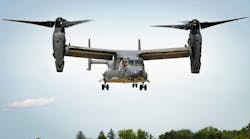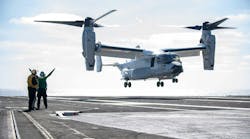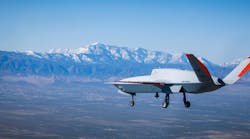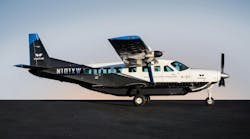PATUXENT RIVER, Md. (NNS) -- The MQ-4C Triton Unmanned Aircraft System (UAS) arrived at Naval Air Station Patuxent River Sept. 18 after completing its inaugural cross-country ferry flight, bringing the Navy closer to delivering this new capability to the fleet.
This flight marked the transition from initial flight test, which established basic safety of flight, to testing that will demonstrate Triton's capability to perform operational missions in the maritime domain.
"Today we brought Triton home to the center of research, development, test and evaluation for naval aviation," said Rear Adm. Mat Winter, who oversees the Program Executive Office for Unmanned Aviation and Strike Weapons (PEO (U&W)) at NAVAIR. "The testing performed here over the next few years is critical to delivering a capability that will provide our warfighter an unparalleled awareness of the maritime environment in locations across the globe."
Winter, along with the flight crew and members from the Triton's Persistent Maritime Unmanned Systems Program Office Office (PMA-262), witnessed the historic landing at 7:53 a.m. During the approximately 11-hour 3,290 nautical mile flight originating from Northrop Grumman's Palmdale, California, facility, the Triton flew along the southern U.S. border, the Gulf of Mexico and across Florida via an approved instrument route. Operators navigated the aircraft up the Atlantic Coast and Chesapeake Bay at altitudes in excess of 50,000 feet to ensure there were no conflicts with civilian air traffic.
"The coordination to bring the Navy's largest unmanned asset across the country was significant and involved many organizations," said Capt. Jim Hoke, PMA-262's program manager. "This phenomenal team executed the system's longest flight to date exactly as planned."
Hoke said this perfect execution was no surprise to him since the system has exceeded performance standards during the course of the last year. Triton has completed 15 test flights prior to today's ferry flight, demonstrating its ability to operate at various speeds and altitudes.
PMA-262 has scheduled Triton operations to start at Pax River within the next several weeks. The Triton integrated test team will conduct further envelope expansion, sensor, communications and interoperability testing.
These are just a few of the many robust tests we will conduct over the next three years, said Mike McDaniel, lead flight test director. Three Triton test vehicles will fly approximately 2,000 hours before achieving initial operational capability in 2017.





